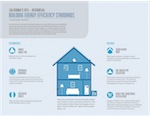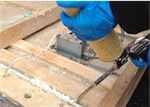Manufacturers have developed a number of technologies to improve window thermal performance in all climates. Some, like warm-edge spacers and gas fills, are widely used across the country. Others, such as tints and films, are only used for special applications.
Warm-edge IG spacer systems.
The aluminum spacer bars traditionally used to separate the two panes in double glazing create a thermal short-circuit around the edge of the glass. Despite the warm center-of-glass temperatures achieved with low-E glass, the bottom edge of the glass was cold and had frequent condensation (Figure 6). Today more than 90 percent of the residential windows sold use some form of “warm-edge” system. The designs vary from low-conductance metals (e.g., stainless steel) to foam or plastic replacements of the aluminum spacer tube. The thermal performance improvement from warm-edge technology is reflected in the total window U-factor rating found on the NFRC label. In addition to thermal performance, however, it’s important to pay attention to window durability. Be sure to compare manufacturers’ warranty provisions – sometimes the best performer will lack long-term warranty support due to concerns about the durability of new materials and technologies.
Gas fills.
Many manufacturers put low-conductance gases, such as argon or krypton, between the glazing layers to enhance the performance gains from low-E. Without low-E, the gas will have little effect. Even with the coating, the window U-factor will typically improve by less than 10 percent. Again, it’s important to read the manufacturer’s warranty to understand their provisions regarding gas retention.
Triple and quad pane glazing.
Double-pane glass is optimized with a low-E coating and gas fill. To provide even better insulating values, some new window designs are incorporating triple and quad-pane systems with multiple low-E coatings (one coating in each air space). Concerns with weight and thickness have some manufacturers replacing the internal layer(s) with plastic or suspended films. Many remain skeptical of the durability of plastics encapsulated in the gap and exposed to sun and thermal cycles. Some newer window designs use thicker sash to accommodate all-glass triple or quad units. Refer to installation instructions to ensure that these products are compatible with your wall system.
Tinted glass.
Tinted glass is sometimes used to reduce heat gain in hot climates. However, tinted glass gets hot in sunlight (from absorption) and suffers more loss of light transmission than spectrally selective low-E coatings. There are some spectral tinted glasses available today, usually light blue or green in color. However, residential windows usually avoid tints, given the market preference for clear glazings. Also, these tints don’t improve the U-factor, so a low-E coating is still required to meet code and Energy Star standards.
Aftermarket applied films.
Tint films are often retrofitted onto windows in rooms that overheat due to direct sunlight. While they can effectively address overheating, the films can be problematic because the low visible light transmission can excessively darken rooms. There can also be problems with film adhesion, and some window manufacturers will void their warranty if tint films have been applied. When buying new or replacement windows, look for products with a low SHGC, indicating that solar control is already built in to the window.
This forum provides you with resources about home renovation, improvement, makeover and repair topics such as cabinet replacement, construction, drainage, drought tolerant landscape, flooring, furnace, furniture, gardening, heating system, home appliances, home performance, kitchen design, landscape planning, low flow toilets, mold removal, non-toxic material, plumbing, remodel planning, retrofit, roof tiles, saving water, solar panel, solar system, water conservation, window replacement, and many others. While we focus on issues in California, particularly in the San Francisco Bay Area, San Jose, Oakland, Alameda, Contra Costa, Dublin, Fremont, Marin, Mountain View, Redwood City, San Ramon, Santa Clara, Santa Cruz, Sausalito, Walnut Creek, most information is applicable in all parts of USA as well as the rest of the world.
Continue reading … 1 2 3 4
5 6







